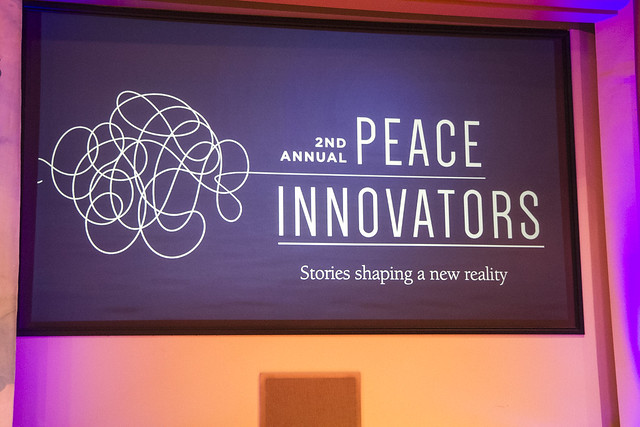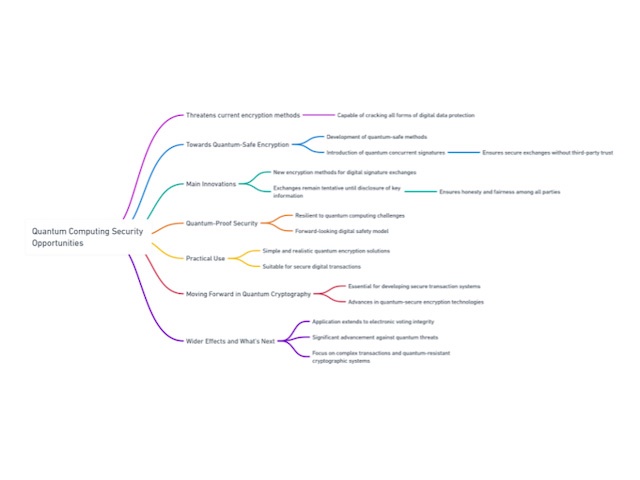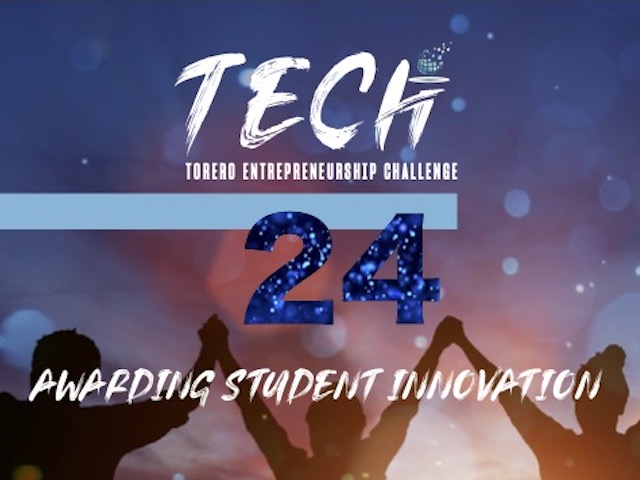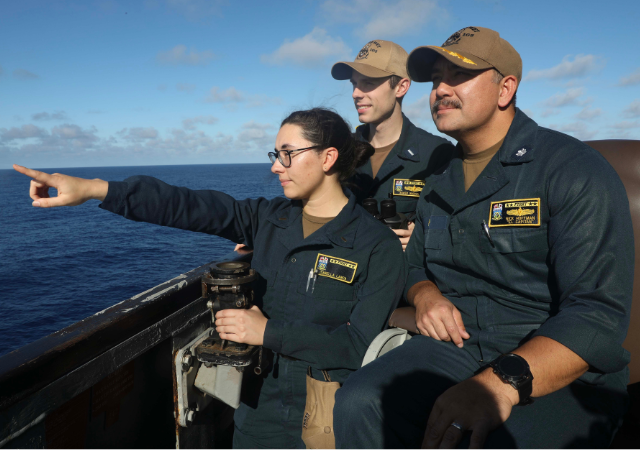Peace Innovators: Speakers Want to Shape Peace Through New Perspectives
Peace is a common goal, an ending we all seek, but working toward it doesn't fit one pathway. In today's faster-than-ever-paced world the means to a solution often relies on variables. It requires us to look at problems differently, from a multitude of angles, to produce clarity and, ultimately, the prosperity of peace.
Thursday night, the Kroc School's second annual Peace Innovators program brought together six University of San Diego speakers from across campus to the Kroc Institute for Peace and Justice Theatre stage to share pathway ideas and to engage the minds of the capacity crowd in attendance. Furthermore, Andy Pendoley was also on stage to perform an artistic visual report of each speaker's talk.
Delivered in a TED-style talk format, Kroc School Professor of Practice Michael Fryer provided a message that peacebuilding works best when those who share a commitment to peace, even if they may not be present to see it fully through, have equal value. Kroc IPJ Executive Director Andrew Blum delved into the importance of facts to promote change. Integrated Engineering Professor Gordon Hoople said to function in today's world through a sociotechnical lens is vital to positive peace. Sociology Assistant Professor Greg Prieto and USD alumna and Mulvaney Center Director of Neighborhood and Community Engaged Partnerships, Maria Silva, shared stories and information for higher education institutions to serve as a supportive and inclusive ally for undocumented youth as college students. School of Business’ Associate Professor of Management, Priya Kannan-Narasimhan, passionately expressed the critical importance of compassion, not profits, to fuel the business world's approach to success.
“Achieving peace and justice is at the center of this university, it’s in the why, what and how we do things,” said Dr. Patricia Marquez, Dean of the Kroc School and Peace Innovators event host. “Because we’re a university, ideas, exploration, dialogue and critical thinking are what we do. That’s why we know that we will not achieve peace and justice simply doing more of the same. It’s why we support and promote innovators. We’re shaping a new reality, a better reality.”
“The Facts of Change” | Dr. Andrew Blum
Blum sees what is happening in society, in a "post-truth world” labeled by some, and it sparked his interest in a closer examination of the importance of facts.
"There are facts, out in the world, and if we go out and identify those facts, positive change happens," he said.
Blum, who has spent much of his career figuring out how knowledge and evidence can be used to shift what organizations do, believes gathering evidence is easy, but understanding what evidence organizations use or don't use and how it competes with other factors when they do decide is important. In his entertaining talk, he shared what he's learned about the role of knowledge to foster positive change.
Many have shared their view on the concept of truth. French philosopher Michel Foucault said "Knowledge linked to power not only assumes the authority of the ‘truth’ but has the power to make itself true,” with truth in quotes,” Blum stated. “There are not facts out in the world to be discovered. There's simply powerful individuals and institutions creating truth."
While it's a sobering thought, Blum then shared a relatively recent quote from Rudy Guiliani, stating, "Truth isn't truth."
"If truth isn't truth," Blum reasoned, "then USD and other universities should just shut down. Our core mission is to find and to teach truth, create knowledge that is true. And I work at a university so, as you might expect, I don't want to go to this extreme. After all, facts are a stubborn thing. Facts help us create change that works."
Looking at how change happens is the starting line. “Change happens when we make different decisions. Human beings decide to do something different. We are all motivated reasoners. We look for facts to confirm our beliefs,” Blum said.
Dr. Andrew Blum delivering his speech at Peace Innovators on March 14, 2019 (click for more photos)
While that can also be part of the problem — a narrowing of the possibilities to simply fit one’s agenda — Blum states: "If we care about facts, if we care about change, and change requires decisions made by messy, imperfect human beings, what do we do? We need to expand our ideas about what facts matter. To expand the kinds of facts we pay attention to, we teach and we learn about. Facts out there in the world and facts about human beings, as well."
He referenced a company called Housing First that first and foremost focuses on getting those who’ve experienced homeless into a home then work from there. At the Kroc School, the IPJ and all other entities, Blum believes its mission is bringing facts and evidence to those who are driving forward the most important change processes in the peacebuilding field and prevention of violence field.
“Social + Technical = Peace” | Dr. Gordon Hoople
As a high school senior looking toward attending college, Hoople had a dilemma. Should he study history or engineering?
“I loved both of these fields, but it seemed I could not pursue both. In my college search, I hadn’t come up across double majors in history and engineering and it seemed the system was set up to push me in one direction or the other — a focus on technical problem solving or a path in the social sciences,” he said.
He ultimately went the engineering route academically and is now a USD engineering professor, but Hoople learned there was a way to combine his passions for problem-solving. He saw through his studies and his work that he was seeing the problem as either social or technical, but that in actuality, problems are a combination of the two. He calls it sociotechnical.
“I realized that to truly have a profound impact on the world, I needed to bring together my love of both history and engineering. Sociotechnical simply highlights the fact that the social and technical are always connected — and they can’t easily be separated.”
Hoople defines sociotechnical thinking as “the ability to identify and solve problems with an understanding of this connection. Approaching problems from a sociotechnical perspective is pivotal to solving the world’s most challenging problems.”
What does this have to do with peace? Johan Galtung, father of peace studies, divided the field into two categories, negative and positive peace. Negative peace is the absence of violence, such as a war being declared over. Positive peace is the integration of human society, such as ideas espoused in Dr. Martin Luther King Jr.’s “I Have a Dream” speech where his words speak to creating a fair and just society.
Dr. Gordon Hoople delivering his talk, "Social + Technical = Peace"
Other ways Hoople feels that a sociotechnical lens can work is achieving some of the United Nations’ 17 Sustainable Developmental Goals; Co-teaching a sociotechnical class in which he and Kroc School Professor Austin Choi-Fitzpatrick promote drone usage to serve as a connector. Two engineering students and two Kroc School students team up to design a drone to have a positive impact on society.
“My message to everyone tonight is that we all must learn to see the world from a sociotechnical perspective … there are incredible benefits to a sociotechnical mindset. If you adopt this approach, you’ll help bring the world one step closer to positive peace.”
“UndocuAllies: Inclusion in an Age of Exclusion” | Dr. Greg Prieto and Maria Silva
Maria Silva and Dr. Greg Prieto support undocumented youth in higher education.
Undocumented immigrant youth in the U.S. grow up believing that the educational opportunities they aspire to would be available to them, the same as any other young person. Since 1982, a Supreme Court case, Plyer v. Doe guarantees access to K-12 education for undocumented students.
“As they make their way through preschool, elementary, middle and high school, teachers instill the promise that education is the key to social mobility. Outside the classroom, parents, mentors and media extol the virtue of a college degree as they climb the ladder of success,” Prieto said. “The message is: Just follow the rules, work hard, do your best, and you’ll be rewarded.”
But a roadblock exists near the end of their high school years. “Fast forward to senior year in high school and we’ve broken this promise. Undocumented youth face this reality the moment they start the college application process. States like Georgia, Alabama and Montana ban undocumented students from public universities,” Silva said. “By contrast, in California, undocumented immigrants receive financial aid in the form of in-state tuition, fee waivers and the Cal Grant. And yet, many still can’t afford the substantial costs of even public higher education largely because they are ineligible for FAFSA. … Higher education presents real borders that are difficult to cross for undocumented students.”
DACA, or Deferred Action for Childhood Arrivals, provides temporary relief from deportation and work authorization for two years. It offers a lesson about the promises and pitfalls of incomplete and temporary incorporation. This stalled state between socioeconomic inclusion and legal exclusion is reflected in survey data about the way that DACA has only just begun to change the lives of these young people. About half of DACA recipients have moved to a job with better pay, better working conditions, benefits, and that better fits their education and training. About half worry about being deported on a daily basis, 66 percent worry that a family member will be deported, and 75 percent worry they won’t be able to see their kids grow up. DACA does not provide a pathway to citizenship, only temporary relief. Neither does it make these youth eligible for federal financial aid. The problem of their status is postponed, not resolved, producing a deep uncertainty about the future.
Prieto and Silva, who together have led an effort to train — so far — more than 100 UndocuAlly campus community members at USD, made a plea on Thursday night: “Why not build bridges instead?”
Said Prieto: “What if we regarded undocumented youth not as takers, but as contributors to our schools and our communities? What if we considered their education not as a cost, but as an investment?”
Silva, who grew up on the Mexico side of the border, Sonora, near Nogales, Ariz., said border towns know far too well that places like that are characterized by their political, economic and social interdependence. “I lived on the Mexico side of the border but commuted to school in Arizona every day. Growing up between the organized chaos of two different countries gave me firsthand experience on the challenges, but also the opportunities that borders pose. The idea of building bridges to connect these two worlds continues to inspire my work with undocumented immigrants on and off campus. So, how do we build bridges to higher education?”
Both speakers shared the visible resources that provide DACA students an inclusive opportunity at USD: Financial aid in the way of merit-based scholarships and no-interest loans, emergency grants, funding for DACA renewals, free access to legal and counseling services, one-on-one case management, peer mentorship and support groups, bilingual web pages with resource information specific to undocumented students. There is an immigration task force on campus. Upon learning that President James T. Harris had found funding to support the first-ever Undocumented Student Scholarship, USD will offer free room and board to all admitted undocumented students beginning in Fall 2019.
While USD and other higher education institutions are making inroads to help undocumented students, Silva and Prieto finished with a call to action.
“We must stop framing immigration as a problem. The problem is not the immigrant community. The problem is our inability to embrace, integrate and create access for this population. The solution is right under our nose. We can make a collective choice to see ourselves in the other, to dignify the contributions undocumented youth have already made to our communities and to support our common aspirations for belonging.”
Michael Fryer | "Building Peace You May Never See”
Fryer shared stories of his English hometown Yorkshire, about the nearby ancient cathedral York Minister and about the Corrymeela community, the oldest center for peace and reconciliation on the island of Ireland. He presented pictures and spoke of time, places and people whose actions, large and small, demonstrated a fierce focus on the end goal of peace to accompany generations to come, being as the reality of peace would surely eclipse their lifetimes.
"When it comes to building peace," Fryer said, "our task is to intentionally create the space in which something might happen. It's just that we might never know what or when that might be."
Fryer likened this concept to his own profession of teaching.
"At the Kroc School, we follow paths. We also develop new ones. As a learning community, our focus is to explore and navigate the complex and challenging world of peace, justice, conflict and social change," he said.
Quoting German writer Thomas Mann, who wrote, "War is only a cowardly escape from the problems of peace," Fryer stated that his aim is to "work alongside my students as we develop the capacity, perspectives and skills to engage with these 'problems of peace.' It's not just increasing knowledge, it's about the quality of our presence, not just intellect. Our approaches to building peace must have one foot grounded in the lived reality while the other foot is in the world of creative possibility and imagination. Balance is key. We learn together and the paths we forge, hopefully, lead the way for others to follow."
Kroc School Professor of Practice Michael Fryer at Peace Innovators on March 14, 2019.
Fryer’s other takeaway is to know that everyone contributes to the peace process and that everyone should be equally respected for their work. Some get far too much credit for their work. Much like the building of a cathedral — the York Minster will turn 800 in 2020 — everyone who had a part in its construction contributed to what it stands for.
“As we look to the future, let’s broaden our understanding of what building peace is and who does it. Even the smallest act has significance,” Fryer said.
“Innovate with Compassion” | Dr. Priya Kannan-Narasimhan
The closing speaker of the night produced a business-focused confession that by today’s standards may seem less uncommon, but it gave Kannan-Narasimhan considerable stress.
“I’m here today as a Peace Innovator because I’m known as a professor who is passionate about sustainable businesses and strongly believes in the power of innovations in business for driving positive social change. However, until a few years ago, I didn’t have the courage to embrace my identity as an academic who could study such topics. I felt compelled to conform. Conform to what is asked, conform to the dominant paradigm in business over decades — that the key purpose of business is to make profits,” she said.
Born and raised in India, a socialist welfare economy built on Gandhian ideals. She graduated with degrees in business, accounting and finance, had jobs in the field and that message was always, simply: “businesses are in the business of making money. My job as a professional employee was to enable businesses to make more money. Workplace Priya was rational, efficient and focused on profits, success and was very successful.”
All along, though, there was another person eager to emerge, but fearful of the ramifications. “There was a hole in my heart, a disconnect. There was an invisible Priya within me who was very sad with all of the suffering around me.”
Growing up in Mumbai and Calcutta where poverty and opulence were juxtaposed — cities with the some of the largest slums and the biggest and best businesses in the world — she was pained by the suffering around her and was determined to do something about her compassionate side.
This “dual paradigm,” as she named it, was still apparent even after leaving industry and in the academic field. It famously, for her, finally spilled over on the same day in which she experienced one of her greatest academic joys.
“I distinctly remember I was in the car, in India, traveling with my family when I heard that a study I had spent almost a decade working on got accepted into one of the top journals in my field. I was thrilled,” she said. “This joy lasted for a few hours until we took a lunch break. As we stepped down from the car by the side of the road in front of the restaurant, a young woman with toddlers approached us begging for food along with several others also begging for food. In their eyes I could see their hunger and I felt their pain. It was an aha moment. It was a moment in which I felt so powerless. None of the research findings in that paper could alleviate their hunger or their pain.”
School of Business Professor of Management Dr. Priya Kannan-Narasimhan
Compassion is the anxiety we feel when we see others suffering in agony and have a genuine desire to do something about it, Kannan-Narasimhan said. Research from a source such as Dr. Emma Seppala, science director for Stanford’s Center of Compassion and Altruism Research and Education, indicates that “although human beings have long been portrayed as selfish beings with self-interest at their very core, a growing body of research suggests that it is the opposite. We are hard-wired to be compassionate and not self-interested. What we know as the survival of the fittest from Charles Darwin is actually the survival of the kindest.”
Hearing this empowers Kannan-Narasimhan. It makes her realize that classes can teach students all they need to know about business, but what we don’t teach enough of is how to engage in their natural compassion to create businesses that can truly transform the world.
She shared stories of compassion in business: First, Warby Parker, an eyeglasses business start-up by four graduate students who turned a personal experience into an online-based company now valued at $1.75 billion. Yet, from day one, they’ve partnered with nonprofits to distribute more than four million pairs of glasses through a Buy a Pair, Give a Pair program. Secondly, East Coast-based Wegman’s Food Markets is an existing company that scaled its business to show compassion for its organizational stakeholders — its 48,000 employees. Late President Robert Wegman led with compassion at every turn. He raised salaries when he took over operations, implemented health care, a defined contribution plan, a 401K plan and a scholarship program all before businesses adopted the corporate social responsibility. Wegman also gave $25 million to Catholic elementary education enabling hundreds of low-income families to provide education for their children regardless of their faith.
They’re just two examples, but it does provide the impetus for including compassion into the business syllabus.
“If compassion is the foundation on which we can create and scale multibillion-dollar businesses then why is the discussion of compassion left out of our classrooms and boardrooms? We talk about sustainable business models, social innovation and entrepreneurship, yet fail to talk of compassion which is the foundation for creating and scaling sustainable models,” she said. “Each one of us has the power to bring our compassion to the forefront to shift the existing paradigm such that doing well is not just a to have — but a must for driving change.”
— Ryan T. Blystone
Contact:
USD News Center
news@sandiego.edu
(619) 260-4681









